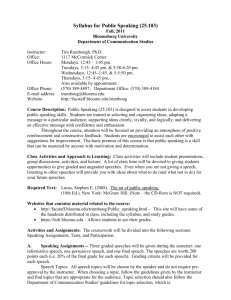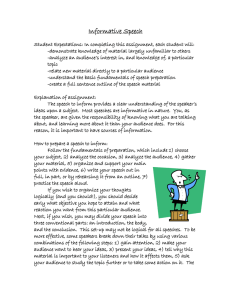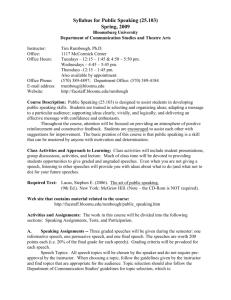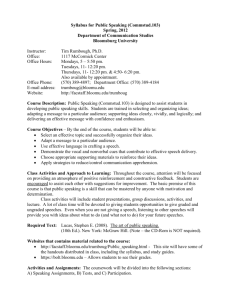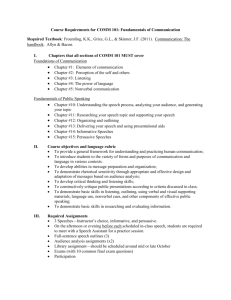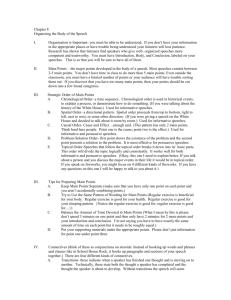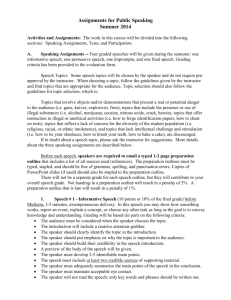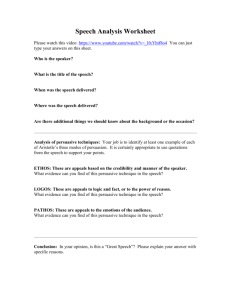Syllabus for Public Speaking (25.103)
advertisement
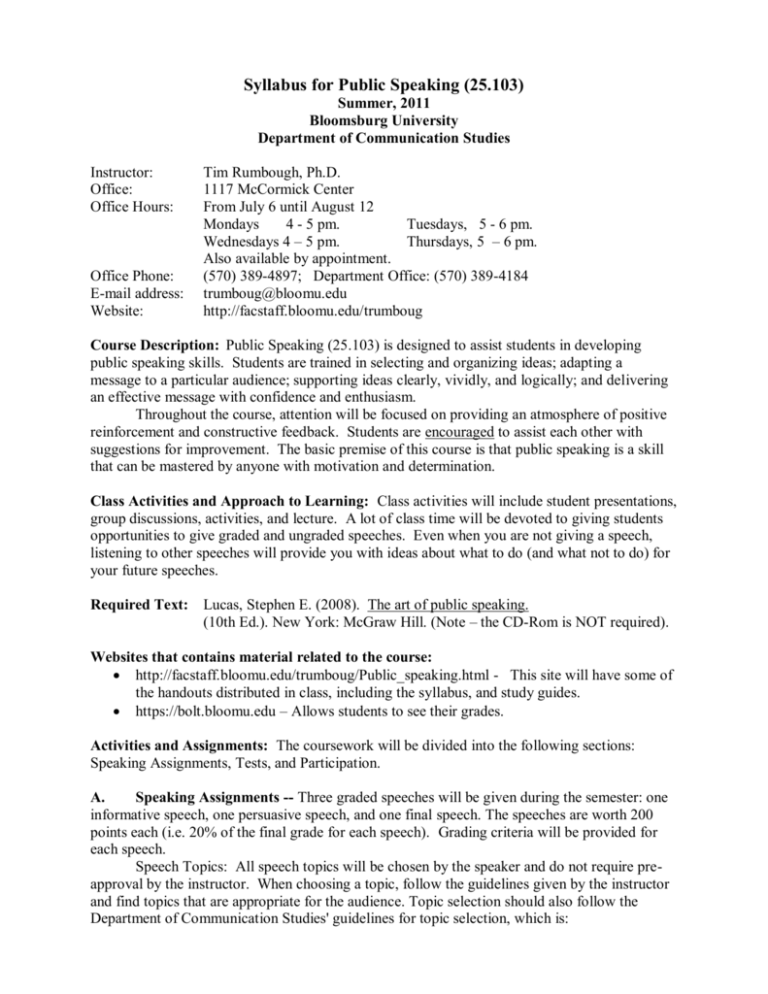
Syllabus for Public Speaking (25.103) Summer, 2011 Bloomsburg University Department of Communication Studies Instructor: Office: Office Hours: Office Phone: E-mail address: Website: Tim Rumbough, Ph.D. 1117 McCormick Center From July 6 until August 12 Mondays 4 - 5 pm. Tuesdays, 5 - 6 pm. Wednesdays 4 – 5 pm. Thursdays, 5 – 6 pm. Also available by appointment. (570) 389-4897; Department Office: (570) 389-4184 trumboug@bloomu.edu http://facstaff.bloomu.edu/trumboug Course Description: Public Speaking (25.103) is designed to assist students in developing public speaking skills. Students are trained in selecting and organizing ideas; adapting a message to a particular audience; supporting ideas clearly, vividly, and logically; and delivering an effective message with confidence and enthusiasm. Throughout the course, attention will be focused on providing an atmosphere of positive reinforcement and constructive feedback. Students are encouraged to assist each other with suggestions for improvement. The basic premise of this course is that public speaking is a skill that can be mastered by anyone with motivation and determination. Class Activities and Approach to Learning: Class activities will include student presentations, group discussions, activities, and lecture. A lot of class time will be devoted to giving students opportunities to give graded and ungraded speeches. Even when you are not giving a speech, listening to other speeches will provide you with ideas about what to do (and what not to do) for your future speeches. Required Text: Lucas, Stephen E. (2008). The art of public speaking. (10th Ed.). New York: McGraw Hill. (Note – the CD-Rom is NOT required). Websites that contains material related to the course: http://facstaff.bloomu.edu/trumboug/Public_speaking.html - This site will have some of the handouts distributed in class, including the syllabus, and study guides. https://bolt.bloomu.edu – Allows students to see their grades. Activities and Assignments: The coursework will be divided into the following sections: Speaking Assignments, Tests, and Participation. A. Speaking Assignments -- Three graded speeches will be given during the semester: one informative speech, one persuasive speech, and one final speech. The speeches are worth 200 points each (i.e. 20% of the final grade for each speech). Grading criteria will be provided for each speech. Speech Topics: All speech topics will be chosen by the speaker and do not require preapproval by the instructor. When choosing a topic, follow the guidelines given by the instructor and find topics that are appropriate for the audience. Topic selection should also follow the Department of Communication Studies' guidelines for topic selection, which is: Public Speaking - 2 Topics that involve objects and/or demonstrations that present a real or potential danger to the audience (i.e. guns, knives, explosives, fires), topics that include the presence or use of illegal substances (i.e. alcohol, marijuana, cocaine, nitrous oxide, crack, heroin), topics that offer instruction in illegal or unethical activities (i.e. how to forge identification papers, how to cheat on tests), topics that reflect a lack of concern for the diversity of the student population (i.e. religious, racial, or ethnic intolerance), and topics that lack intellectual challenge and stimulation (i.e. how to tie your shoelaces, how to brush your teeth, how to bake a cake), are discouraged. If in doubt about a speech topic, please ask the instructor for suggestions. More details about the three speaking assignments are described below. Before each speech, speakers are required to hand-in a typed 2-3 page preparation outline that includes a list of all sources used (a bibliography). The preparation outline is described in chapter 10 of the textbook. A sample preparation outline will be distributed in class to give you an idea of how to write it. The preparation outlines must be typed, stapled, and free of grammar, spelling, and punctuation errors or points will be deducted. Copies of PowerPoint slides (if used, print 6 slides per page) must also be stapled to the preparation outline. There will not be a separate grade for each speech outline, but they will contribute to your overall speech grade. Failure to hand-in a preparation outline will result in a penalty of 20% (A “B+” speech would become a “D+” speech). A preparation outline that is late (i.e. handed in after you deliver the speech) will result in a penalty of 10%. 1. Speech # 1 - Informative Speech, 6-8 minutes, extemporaneous delivery. In this speech you may show how something works, report an event, explain a concept, or choose any other task as long as the goal is to convey knowledge and understanding. Grading will be based (in part) on the following criteria: The audience must be considered when the speaker chooses the topic. The introduction will include a creative attention-grabber. The speaker should clearly identify the topic in the introduction. The speaker should put emphasis on why the topic is important to the audience. The speaker should build their credibility in the speech introduction. A preview of the body of the speech will be given. The speaker must develop 2-5 identifiable main points. The speech must include at least three credible sources of supporting material. The speaker must adequately summarize the main points of the speech in the conclusion. The speaker must maintain acceptable eye contact. The speaker will not read the speech; only key words and phrases should be written out. Speaking notes should not distract the audience. The speaker’s movement, posture, and appearance should be appropriate. The time limit of the speech must be met. The speaker will hand-in a typed 2-3 page preparation outline which follows the guidelines that are discussed in the book and class handout. Public Speaking - 3 2. Speech # 2 - Persuasive Speech with Visual Aids, 6-8 minutes, extemporaneous delivery. In this speech you will attempt to persuade members of the audience to change a belief or to perform some action. You will choose one of the following options: Choice #1: Pick a persuasive speech topic that members of the audience do not control directly, but have the power to affect collectively. Examples of persuasive topics that require group action include: passing a law that changes the drinking age, changing the format of a local radio station, getting more computer labs on campus, etc. Topics generally fall into the policy category. These speeches may include asking the audience to sign a petition, send a form letter, or other actions that may have an impact on changing or establishing a policy. Choice #2: Pick a persuasive speech topic in which individual audience members have direct control. Examples of topics include: persuading the individuals in the audience to: eat healthy food, buy a particular product – such as “Satellite Radio”, wear seat belts, go to Cancun Mexico, give blood, become an organ donor, etc. Grading criteria for this speech includes: choice of subject, audience adaptation, use of language, physical and vocal delivery, eye contact, credibility of sources (a minimum of three), and use of emotional and logical appeal. You may wish to organize the speech by using Monroe's Motivated Sequence (i.e. Attention, Need, Satisfaction, Visualization, Action). Additional grading criteria will be provided. Another requirement of this assignment is that you must use a minimum of two visual aids during the speech. The visual aids could be any combination of video clips, transparencies, bringing in objects, using 2 (or more) PowerPoint slides, websites, etc. You will be graded on the quality and appropriateness of your visual aid as well as their integration into your speech. If you use PowerPoint slides or transparencies, please attach a copy to your preparation outline. 3. Speech # 3 - Final Speech with PowerPoint, 6-8 minutes, extemporaneous delivery. When choosing the topic for the final speech, you may choose between a humorous, informative, or persuasive speech. The topic for this speech must be different than the topic used in your previous speeches. Microsoft PowerPoint will be used for this speech. A minimum of 10 PowerPoint slides must be used. Additional audio/visual aids may also be used (overhead transparencies, objects, video clips, CD clips, demonstration of an Internet site, etc.) You will be graded upon the quality and appropriateness of your PowerPoint slides as well as their integration into your speech. You must attach a copy of your PowerPoint slides (handouts - 6 slides per page) to your preparation outline. We’ll discuss how to do this in class. Topic choice # 1 - Humorous Speech. The purpose of this speech is to entertain. This humorous speech must have a central theme and should not be a series of unrelated jokes. Choose a topic based on your own experience and one in which the audience can easily relate. Sample topics that I have seen include: games people play when dating, using slang, the tooth fairy, pickup lines, Bill Gates’ wealth, living in the dorms (an analysis of types of roommates), the best jobs in America, the “real” differences between men and women, methods of procrastination, how squirrels are taking over the world, etc. Choosing this option will allow you to show your creativity to the class while having a lot of fun at the same time. If you choose the humorous speech, research is not required, but if you find sources for the speech, then you still need to cite them. Topic Choice # 2 -- Informative Speech. Using the same principles learned in your first speech, you will show how something works, report an event, explain a concept, or choose any other task as long as the goal is to convey knowledge and understanding. Topic Choice # 3 -- Persuasive Speech. Using the same principles learned in the second speech, you will attempt to persuade audience members to change their attitudes or perform some action. Public Speaking - 4 B. Tests -- There will be two multiple-choice tests worth 150 points each (i.e. 15% of the final grade). Test material comes from the textbook and from material presented in class. A separate study guide will be distributed before each test. Chapters that should be studied for each test are identified below: Test 1: Ch. 4 Ch. 5 Ch. 6 Ch. 7 Ch. 8 Selecting a Topic and Purpose Ch. Analyzing the Audience Ch. Gathering Materials Ch. Supporting Your Ideas Ch. Organizing the Body of the Speech 9 10 13 14 Beginning and Ending the Speech Outlining the Speech Using Visual Aids Speaking to Inform Ch. 1 Ch. 2 Ch. 3 Ch. 11 Speaking in Public Ethics and Public Speaking Listening Using Language 12 15 16 17 Delivery Speaking to Persuade Methods of Persuasion Speaking on Special Occasions Test II: Ch. Ch. Ch. Ch. NOTE: The first test does not cover chapters 1, 2, and 3. However, it is recommended that you read these chapters during the first two weeks of class. C. Participation (100 points, 10% of final grade). Points will be awarded for the quality and quantity of your class participation. The factors that contribute to your participation grade include: You’ll be asked to prepare and deliver several ungraded impromptu speeches. You will create, make copies, and give an audience analysis survey before your first speech. For each round of speeches, you will evaluate a classmate’s speech. You will do this by using class time to complete a standardized speech evaluation form. This peer evaluation does not affect the speaker’s grade, but it does provide additional feedback for the speaker. You should be prepared to offer positive reinforcement and constructive critical feedback after hearing each speech. You should be prepared to question, offer examples, challenge, or defend any of the positions and ideas that are discussed in class. Your input is valuable, and you are encouraged to share it with your classmates and professor. Texting in class will reduce your participation grade. To minimize disruptions of class, make sure your cell phone is turned off or set to vibrate mode. Avoid absences, be in class on time, and don’t leave early. (See Class Policies below). Public Speaking - 5 II. Grading Criteria A. Grades will be awarded based on the following: Three Speeches -- worth up to 200 points each = 60% of the final grade. Two Tests -- worth up to 150 points each = 30% of the final grade. Participation – worth up to 100 points = 10% of the final grade. B. Here are the points you will need to earn the appropriate grade: A AB+ B BC+ C. = = = = = = 934 – 1000 900 – 933 867 – 899 834 – 866 800 – 833 767 – 799 C CD+ D E = = = = = 734 - 766 700 - 733 667 - 699 634 - 666 633 or less To help you figure your own grade as the semester progresses, you can fill in the appropriate numbers when your grades are returned: Speech 1 out of 200 points Speech 2 out of 200 points Speech 3 out of 200 points Exam 1 out of 150 points Exam 2 out of 150 points Participation out of 100 points Total points earned = out of 1000 (Note: unexcused absences will result in point deductions from the final point total.) III. Class Policies A. Attendance -- In order for you to meet the objectives of this course, class attendance is necessary. 1. Excused Absences - If you have a valid reason for being absent (illness, family emergency, school sponsored activity, professional obligation, or severe weather emergency), then you must present a written excuse within one week of your return. If you do not submit a written excuse, then the absence will be recorded as unexcused. (Telephone messages left on my voice mail or with the department secretary are not written excuses.) 2. Unexcused Absences. Unexcused absences will negatively affect your final grade. For classes that meet two times a week, you are allowed to miss 2 classes without penalty. Beyond this, each unexcused absence will result in a grade reduction of 3% (-30 points) from your final grade. For example, a student has 2 unexcused absences. Their point reduction to their final grade is 30 points. (2 unexcused absences – 1 = 1 x 30 points = 30 points). 3. Absences (either excused or unexcused) will affect your participation grade. Public Speaking - 6 B. Being late to class/leaving early-- There are several reasons why you need to be in class on time. 1. Showing up late or leaving early can be very distracting to the professor and your fellow students. 2. Announcements regarding class assignments are made at the beginning of class or at the end of class, being late/leaving early may prevent you from obtaining important information. 3. If you show up late or leave early you might miss signing the attendance sheet, and you'll be marked absent for the day. 4. Being late to class or leaving early will count as a half absence (see attendance policy above) and may affect your final grade. So please be in class on time. C. Late Assignments -- All assignments must be completed when scheduled. Failure to comply with this requirement will result in a grade reduction of 15% unless otherwise approved by your instructor. (A “B” speech would become a “D+” Speech.). If you must be absent on the day of your speech, you should contact the instructor and/or make arrangements in advance to trade speaking days with one of your classmates. If you trade speaking days with a classmate, please inform me of the change in writing so that there are no misunderstandings. D. Make-up Exams -- Make-up tests will only be allowed for students with excused absences. The make-up exam may include essay, short answer, and/or multiple-choice questions. E. Academic Integrity -- It is unethical to use as your own, a speech or outline prepared, in whole or in part, by someone else. It is unethical to use information from a source (such as a website) and pretend that it is your own work. Sources used should be cited within the preparation outline and while you are giving the speech. The best speeches do not rely heavily upon a single source, but represent ideas formulated from several sources. Source materials are expected to be used for building a background of knowledge about the subject. Original work is required of every student, and cheating/plagiarism will result in a “0” for the assignment or an “E” for the course. According to the Bloomsburg University Undergraduate Catalog, “To plagiarize is to steal or use without acknowledgment the ideas, words, etc. of another person.” All aspects of the Bloomsburg University’s Academic Integrity Policy (http://www.bloomu.edu/policies/3512.php) will be followed for this course, and it is a good idea for all students to be familiar with it. If you have any doubts about what constitutes plagiarism, please ask! F. Tutorial Services - If you feel you need extra help to improve your academic performance in this course or any of your other courses, please consider requesting a tutor in University Tutorial Services (UTS). UTS offers peer tutoring at no charge to Bloomsburg University students. The UTS office is located in Warren Student Services Center, Room 13. G. Students with disabilities - Students with a documented disability should see me as soon as possible to arrange for accommodations if needed. Additional information for students with disabilities can be obtained from Office of Accommodative Services for Students with Disabilities, Student Services Center, Room 043, or call (570) 389-4491 (V/TTY). Public Speaking - 7 Public Speaking -- Class Agenda Tuesday/Thursday - Summer, 2011 Note: This agenda will give you an idea what will be discussed in class. Topics and due dates may change. Date July Chapter 7 Th 1, 4, 14 Course Introduction, Student Survey, Introduction Speech (Activity), Choosing Speech Topics 12 T 5, 6, 7 Bring in Topic for Speech #1 Audience Analysis, Researching the topic, Supporting Materials. 14 Th 8, 9, 10 Speech Organization, Organization Activity, Outlining, Introductions, Conclusions, Connectives, Preparation Outlines. Audience Analysis Survey Due (Make copies for everyone) 19 T 12 Speech Delivery, Speech Evaluations, Sample Speeches (Video), Speech Organization and Delivery Activity 21 Th 26 T Speech # 1 - (Informative Speech) 13 28 Th 15, 16 August Activity Speech # 1 – continued. Topics for Speech 2. Communication Apprehension. Visual Aids. Using PowerPoint. Activity TBA. Exam # 1, Chapters 4, 5, 6, 7, 8, 9, 10, 13, 14. Persuasive Speaking, Monroe's Motivated Sequence, Activity. 2 T Speech # 2 - (Persuasive Speech with visual aids), Return Exam. 4 Th 9 T Speech # 3 - (Final Speech – Humorous, informative, or persuasive speech using PowerPoint); Return Exam 11 Th Speech # 3 – continued. Activity TBA. Course Evaluation. 17 Exam # 2, Chapters 1, 2, 3, 11, 12, 15, 16, 17. Speech # 2 – continued. Discussion about Speech 3. Hot Topic Activity. Public Speaking - 7 Public Speaking -- Class Agenda Monday/Wednesday - Summer, 2011 Note: This agenda will give you an idea what will be discussed in class. Topics and due dates may change. Date July Chapter 6 W 1, 4, 14 Course Introduction, Student Survey, Introduction Speech (Activity), Choosing Speech Topics 11 M 5, 6, 7 Bring in Topic for Speech #1 Audience Analysis, Researching the topic, Supporting Materials. 13 W 8, 9, 10 Speech Organization, Organization Activity, Outlining, Introductions, Conclusions, Connectives, Preparation Outlines. Audience Analysis Survey Due (Make copies for everyone) 18 M 12 Speech Delivery, Speech Evaluations, Sample Speeches (Video), Speech Organization and Delivery Activity 20 W 25 M Speech # 1 - (Informative Speech) 13 27 W 15, 16 August Activity Speech # 1 – continued. Topics for Speech 2. Communication Apprehension. Visual Aids. Using PowerPoint. Activity TBA. Exam # 1, Chapters 4, 5, 6, 7, 8, 9, 10, 13, 14. Persuasive Speaking, Monroe's Motivated Sequence, Activity. 1 M Speech # 2 - (Persuasive Speech with visual aids), Return Exam. 3 W 8 M Speech # 3 - (Final Speech – Humorous, informative, or persuasive speech using PowerPoint); Return Exam 10 W Speech # 3 – continued. Activity TBA. Course Evaluation. 17 Exam # 2, Chapters 1, 2, 3, 11, 12, 15, 16, 17. Speech # 2 – continued. Discussion about Speech 3. Hot Topic Activity.

